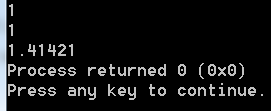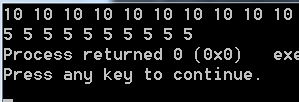这是我第一篇CSDN博客,本人学习C刚刚半年,写的不好或者有错的请见谅!
该篇用于学习一些基础的C++函数(有些属于STL)
博客注重:for萌新(我):简单!一看就懂!有用!复杂的有编程输出!
binary_search 二分查找某个元素是否出现
·头文件:#include < algorithm >
·函数模板:binary_search(arr[],arr[]+size , indx)
·参数说明:
arr[]: 数组首地址
size:数组元素个数
indx:需要查找的值
·函数功能: 在数组中以二分法检索的方式查找,那复杂度为O(log n)
若在数组(要求数组元素非递减)中查找到indx元素则真,若查找不到则返回值为假。
#include <iostream>
#include <algorithm>
using namespace std;
int arr[500050];
int main()
{
for(int i=0;i<10000;i++)
{
arr[i]=i;
}
cout << binary_search(arr,arr+10000,55) << endl; //找得到55
cout << binary_search(arr,arr+10000,-1) << endl; //找不到-1
return 0;
}
输出结果:

Pair 数据对
·头文件: #include< utility >
·定义方法:pair<T1, T2> P;
·含义:表示P有两个类型,类型T1与类型T2
例子:
[默认初始化] pair< int , string >My_Pair ;
[自己初始化] pair< int , string >My_Pair2(100,"score") ;
[用别的初始化]pair< int , string >My_Pair3(My_Pair4) ;
[或者这样]pair< int , string >My_Pair3=My_Pair4 ;
默认初始化之后怎么修改P的内容呢?用make_pair(a,b) 函数!
pair< int , string > My_Pair ;
My_Pair=make_pair(100,"score") ;
怎么输出P的内容呢? T1与T2相当于P的第一个内容和第二个内容
cout << P.first << endl << P.second << endl;
不过,T1 T2你也可以用结构体或者也是pair类型的进行套娃!
例子一:
pair < pair < int , int > , string > P1(make_pair(11,12),"A");
cout << P1.first.first << " " << P1.first.second << " " << P1.second;
例子二:
#include <iostream>
#include <cmath>
#include <utility>
using namespace std;
struct pt{
int x;
int y;
};
int main()
{
pair < pt , double > P1;
P1.first.x=1;
P1.first.y=1;
P1.second = sqrt(P1.first.x*P1.first.x+P1.first.y*P1.first.y);
cout << P1.first.x << endl << P1.first.y << endl << P1.second;
return 0;
}
输出:

·pair的比较:优先比较first,first相同再比较second
使用> , >= , < , <= , == , != 进行pair的比较操作
if(My_Pair1 > My_Pair2)cout << "Something";
next_permutation 全排列作用
·头文件: #include < algorithm >
·用法 next_permutation(arr,arr+size);
·作用:产生该数组的下一全排列
#include <iostream>
#include <cstdio>
#include <algorithm>
using namespace std;
int main()
{
int n=4;
int a[4]={0};
for(int i=0;i<n;i++)a[i]=i; //赋值
do{
for(int i=0;i<n;i++) //输出该状态下的数组
printf("%d ",a[i]);
puts("");
}while(next_permutation(a,a+n));//核心函数
return 0;
}
输出:

如果数组中有相同的数字会怎么样呢?
#include <iostream>
#include <cstdio>
#include <algorithm>
using namespace std;
int main()
{
int n=4;
int a[4]={1,2,2,3}; //赋值
do{
for(int i=0;i<n;i++)
printf("%d ",a[i]);
puts("");
}while(next_permutation(a,a+n));
return 0;
}
结果:

简单好懂,不会出现重复的排列。
当然,它也能为字符串排列,都是按照字典序排序的,因为char类型是以unsigned_int类型储存的
swap 交换函数
·作用:交换变量/数组/容器 等
简单的例子:
int a=1,b=2;
swap(a,b);
int a[]={1,2,3};
int b[]={3,2,1};
swap(a,b);
#include <iostream>
#include <cstdio>
#include <vector>
#include <algorithm>
using namespace std;
int main()
{
vector<int>V1(10,10),V2(10,5); //容器
for(vector<int>::iterator it=V1.begin();it!=V1.end();it++)
cout << *it << " ";
swap(V1,V2);
puts("");
for(vector<int>::iterator it=V1.begin();it!=V1.end();it++)
cout << *it << " ";
return 0;
}
结果:

memset 初始化
·头文件:#include < string.h >
·作用:初始化高维数组,速度比for一遍更加快!数组越大越快!
·用法:memset(arr,num,size);
例子:
memset(arr1,0,sizeof(arr1));
memset(arr2,-1,sizeof(int)*10);
注意:只能初始化0与-1!!因为0是全位为0,-1是全位为1,初始化其他数会出错
fill 填充
·头文件:#include < algorithm >
·作用:填充数组或者容器以你想要的内容
·写法
fill(arr+start,arr+end,num);
fill(myvector.begin(), myvector.end() , num);
例子:
int a[100]={0}; fill(a+2,a+10,5);
这样数组a就会变成 0 0 5 5 5 5 5 5 5 5 0 0 0 0 0 0 0……






















 2047
2047











 被折叠的 条评论
为什么被折叠?
被折叠的 条评论
为什么被折叠?








